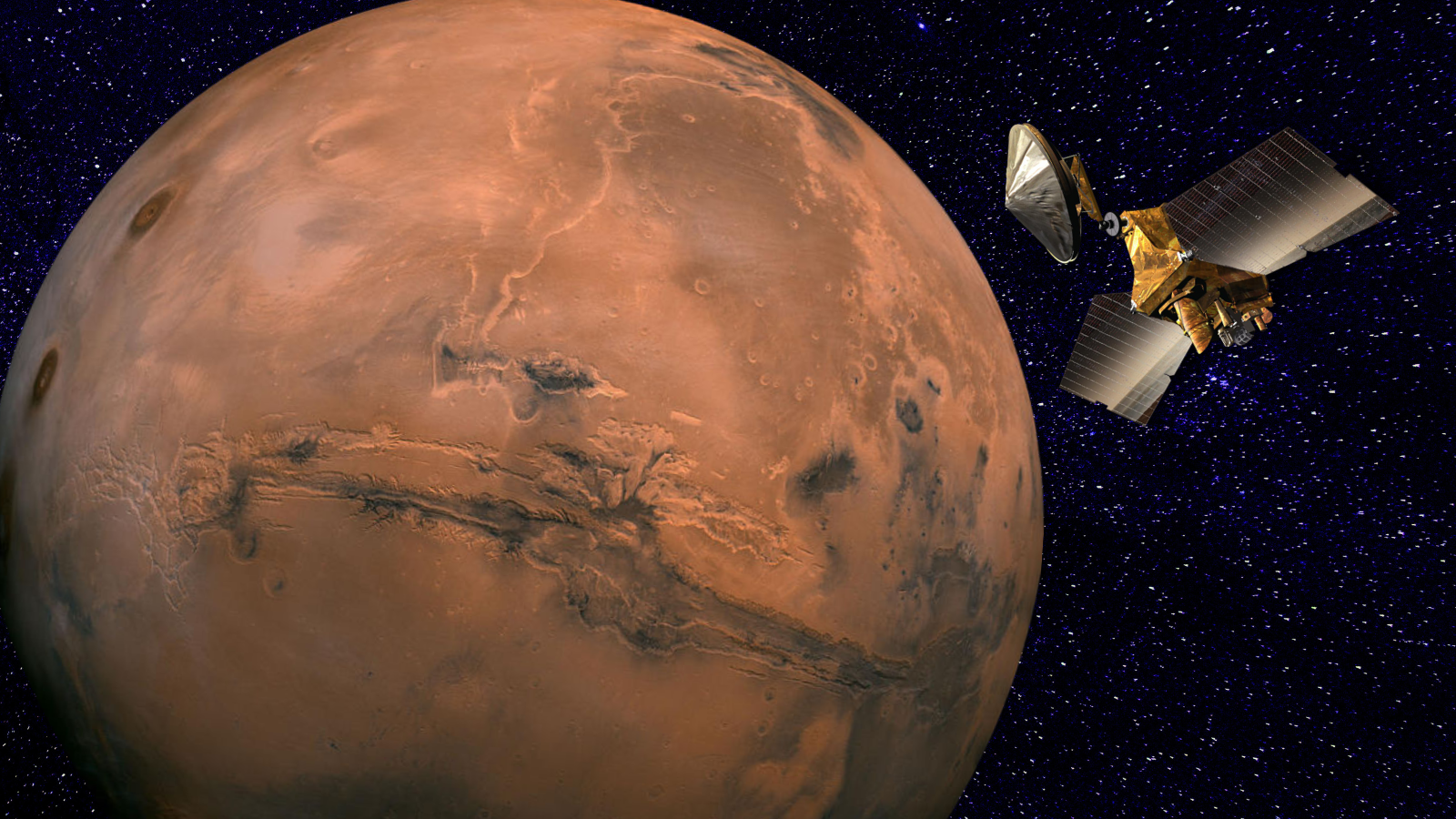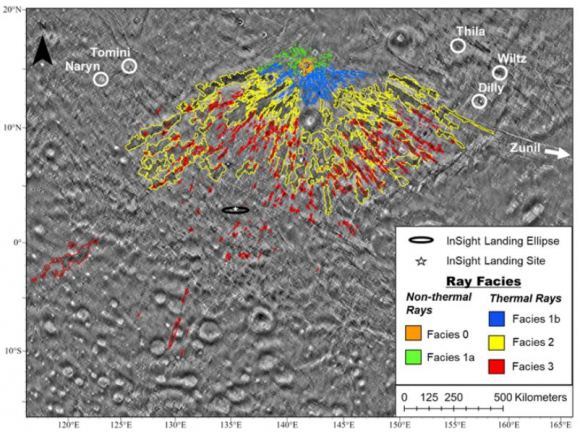Over two million years ago, a giant asteroid slammed into Mars, scarring the surface with one massive crater and around two billion smaller individual craters. These secondary craters appear across a region of 1,000 miles (1,800 kilometers), making this asteroid event one of the biggest impacts seen on the Red Planet in relatively recent history.
Asteroids massive enough to create widespread destruction like this are estimated to impact Mars just once every 3 million years.
The impact occurred at the equator of Mars in a region humanity has named Elysium Planitia; it left behind a main, 8.6-mile (13.9-km) wide and 0.62-mile (1-km) deep crater called Corinto. The secondary craters from the impact, on the other hand, range in size from 656 feet (200 meters) to 0.8 miles (1.3 km) in diameter and extend outward in a large “ray system,” according to the scientists behind the results.
Despite being 2.3 million years old, the crater and its secondaries — some of which are carved into lava flows originating from the summit of the extinct Martian volcano Elysium Mons — are considered to be extremely young by the team.
“Corinto crater is a fresh impact crater in Elysium Planitia that produced one of the most extensive systems of thermal rays and secondary craters on Mars, extending around 1,243 miles (2,000 km) to the south and covering a nearly 180° arc on Mars,” the team wrote in a related study.
An illustration shows the Mars Reconnaissance Orbiter collecting data in situ around the Red Planet. (Image credit: Robert Lea/NASA)
The authors explained how they employed both thermal and visible imaging data collected by NASA’s Mars Reconnaissance Orbiter to describe the crater and blanket of fragments, or “ejecta,” thrown into the Martian atmosphere by the impact. Ejecta refers to any material that’s “ejected” from a crater as a result of some impact. In this case, the ejecta are pieces of Mars shot out from the giant, main crater cavity formed due to the asteroid’s crash.
This data, gathered by the spacecraft’s High-Resolution Imaging Experiment (HiRISE) and Context Camera (CTX) instruments, was given to a machine learning program that separated this impact’s ejecta-caused craters from other Martian craters originating from asteroid strike events specifically. This information was then used to estimate the age of the impact and the total number of secondary craters the initial impact generated.
Measuring the distribution of secondary craters extending out from Corinto, the team found the greatest concentrations to the south and southwest of the main impact crater.
There is a lack of ejecta to the north of the crater, which the scientists think indicates the asteroid that caused this devastation entered the Red Planet’s atmosphere at an angle of around 30 to 45 degrees from the north or northeast.
The furthest secondary craters found by the researchers indicated that some of the ejecta from the impact were launched as far as 1,150 miles (1,850 km). That’s about four times the length of the Grand Canyon.
A graphical representation of the ejecta debris field extending from Corinto. (Image credit: Golombek et al)
The secondary craters didn’t just vary in distance from the main impact zone and in size, however. The team behind the findings also classified them in relation to their shape. Some were round and semi-circular, while others appeared “flattened circular,” or “elliptical.”
The researchers determined that the shape, or “morphology,” taken by the secondary craters related to the speed at which the fragments that created them were ejected, the size of those fragments, and the surface composition of the Martian region on which they crashed. Close to Corinto, the secondary craters took the form of semi-circles, with elliptical-shaped craters found further from the main impact zone.
“The large number of secondary craters formed by Corinto are consistent with most of the ejected material being strong, competent basalt,” the team wrote.
Basalts are volcanic rocks formed by the rapid cooling of lava rich in magnesium and iron, so the fragments likely represent lava that previously spewed from the volcano that the asteroid slammed into.
The composition of some of the ejecta launched from Mars’ surface by this asteroid impact indicate the space rock slammed down into water or ice. This is also indicated by “pits” spread across the floor of the Corinto crater, which imply the drainage of water or gas released by the effect of the impact on ice-rich materials.
The team’s results were presented at the 55th annual Lunar and Planetary Science Conference in Texas earlier in March.
News Related
-
Anyone who’s purchased gift baskets to hand out to loved ones this holiday season might need to find a backup present after the latest food recall that involves festive cookies. Gift basket company Wine Country Gift Baskets just announced that it is voluntarily recalling all gift baskets that feature Acorn Baking ...
See Details:
Recall Just Announced For Popular Cookies Featured In Holiday Gift Baskets
-
LOS ANGELES: Quarterback Jalen Hurts ran in an overtime touchdown to give the Philadelphia Eagles a 37-34 NFL win over the Buffalo Bills Sunday (Monday in Manila) and move them to 10-1 on the season. The Eagles, who lost the Super Bowl to Kansas City last season, trailed at half-time ...
See Details:
Eagles rally past Bills in overtime as Chiefs win
-
Yen Makabenta First word WHILE UN Secretary-General Antonio Guterres and other promoters of the climate emergency are preparing to convene the 28th conference of the parties (COP28) of the UN Framework Convention on Climate Change (UNFCCC) in the United Arab Emirates, starting on November 30 and stretching to December 12, ...
See Details:
Reality bites the green energy agenda
-
Sandigan orders Marcos Sr. pal to pay workers The Sandiganbayan has ordered the enforcement of a July 2023 ruling ordering a Marcos Sr. associate to pay a lumber company’s workers P2.1 million in damages as well as return 60 percent of their company’s shares and pay all unpaid benefits. The ...
See Details:
Sandigan orders Marcos Sr. pal to pay workers
-
DSWD: Shear line, LPA affect 1.2 million people; over 18,000 families evacuated MANILA, Philippines – More than 18,000 families have fled to evacuation centers across flood-affected regions in the country due to the impact of the shear line and low pressure area. Department of Social Welfare and Development (DSWD) gave ...
See Details:
DSWD: Shear line, LPA affect 1.2 million people; over 18,000 families evacuated
-
-
MANILA, Philippines: The entire Luzon, including Metro Manila, is expected to experience isolated rain showers and thunderstorms as the northeast monsoon (“amihan”) and easterlies will be affecting the country over the next 24 hours, the state-run weather agency said on Tuesday. Weather specialist Patrick del Mundo of the Philippine Atmospheric ...
See Details:
Rain showers, thunderstorms over Luzon, including Metro Manila — Pagasa
-
Attention, Naruto fans! You can soon watch the famous anime’s live-action adaptation as it finally has a confirmed writer. According to a Variety report, the beloved manga and anime series is set to head to big screens for its live-action adaptation under Lionsgate. It will be written by Tasha Hao, ...
See Details:
'Naruto' live-action film adaptation is in the works
-
Attention, Naruto fans! You can soon watch the famous anime’s live-action adaptation as it finally has a confirmed writer. According to a Variety report, the beloved manga and anime series is set to head to big screens for its live-action adaptation under Lionsgate. It will be written by Tasha Hao, ...
See Details:
NASA Highlights Stingray Nebula
-
Attention, Naruto fans! You can soon watch the famous anime’s live-action adaptation as it finally has a confirmed writer. According to a Variety report, the beloved manga and anime series is set to head to big screens for its live-action adaptation under Lionsgate. It will be written by Tasha Hao, ...
See Details:
Manila's Lagusnilad underpass opens
-
Attention, Naruto fans! You can soon watch the famous anime’s live-action adaptation as it finally has a confirmed writer. According to a Variety report, the beloved manga and anime series is set to head to big screens for its live-action adaptation under Lionsgate. It will be written by Tasha Hao, ...
See Details:
China probes debt-ridden financial giant
-
Attention, Naruto fans! You can soon watch the famous anime’s live-action adaptation as it finally has a confirmed writer. According to a Variety report, the beloved manga and anime series is set to head to big screens for its live-action adaptation under Lionsgate. It will be written by Tasha Hao, ...
See Details:
China's VUCA situation
-
Attention, Naruto fans! You can soon watch the famous anime’s live-action adaptation as it finally has a confirmed writer. According to a Variety report, the beloved manga and anime series is set to head to big screens for its live-action adaptation under Lionsgate. It will be written by Tasha Hao, ...
See Details:
Unraveling the mystery that is diabetes
-
Attention, Naruto fans! You can soon watch the famous anime’s live-action adaptation as it finally has a confirmed writer. According to a Variety report, the beloved manga and anime series is set to head to big screens for its live-action adaptation under Lionsgate. It will be written by Tasha Hao, ...
See Details:
Bangladesh's nuke plant is not going to steal PH investments
OTHER NEWS
ALIW Awards Foundation Inc. President Alice H. Reyes has released the names of finalists for the 2023 Aliw Awards to be presented on Dec. 11, 2023, at the Manila Hotel ...
Read more »
WhatsApp Web gains the feature of single-view photos and videos (Photo: Unsplash) The WhatsApp Web, the desktop version of the popular messaging app from Meta, has received an update allowing ...
Read more »
Young athletes’ time to shine in Siklab Awards MANILA, Philippines — The future heroes of Philippine sports will be honored during the third Siklab Youth Sports Awards on Dec. 4 ...
Read more »
Graphics by Jannielyn Ann Bigtas A local government official said Monday that five to 10 barangays in Northern Samar are still isolated following the massive flooding in the area last ...
Read more »
DyipPay app lets you pay jeepney fare, book tricycles “Barya lang po sa umaga.” Everyone who rides jeepneys knows this rule: it may not be an actual law, but it’s ...
Read more »
Updated In-Season Tournament Bracket ahead of pool play finale Tuesday will mark the last day of pool play for the inaugural NBA In-Season Tournament. From there, six first-place teams and ...
Read more »
PCG forms teams for maritime emergency response MANILA, Philippines — Recent incidents of fishermen lost in the waters off Southern Tagalog have prompted the Philippine Coast Guard (PCG) to form ...
Read more »


